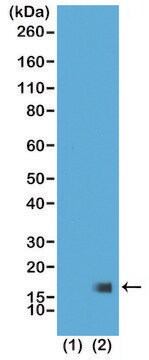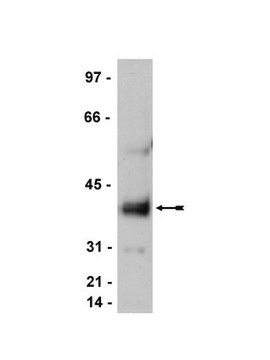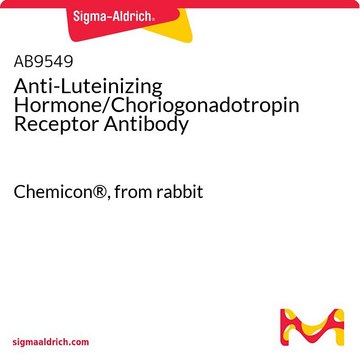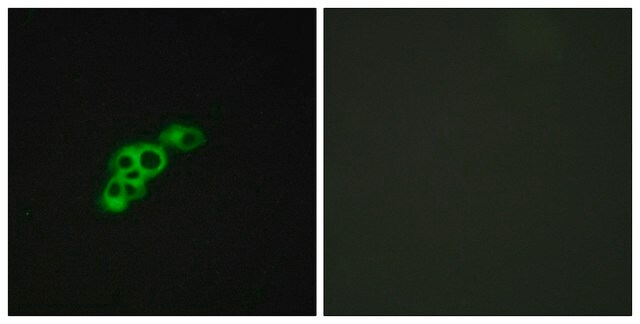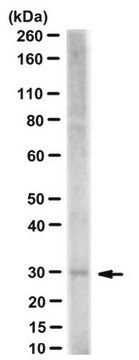MABE1079
Anti-TAF10/TAFII30 Antibody, clone 6TA-2B11
ascites fluid, clone 6TA-2B11, from mouse
Synonym(e):
Transcription initiation factor TFIID subunit 10, STAF28, TAF(II)30, TAFII-30, TAFII30, Transcription initiation factor TFIID 30 kDa subunit
About This Item
IP
WB
immunoprecipitation (IP): suitable
western blot: suitable
Empfohlene Produkte
Biologische Quelle
mouse
Qualitätsniveau
Antikörperform
ascites fluid
Antikörper-Produkttyp
primary antibodies
Klon
6TA-2B11, monoclonal
Speziesreaktivität
mouse, human
Methode(n)
immunocytochemistry: suitable
immunoprecipitation (IP): suitable
western blot: suitable
Isotyp
IgG1κ
NCBI-Hinterlegungsnummer
UniProt-Hinterlegungsnummer
Versandbedingung
dry ice
Posttranslationale Modifikation Target
unmodified
Angaben zum Gen
human ... TAF10(6881)
Allgemeine Beschreibung
Spezifität
Immunogen
Anwendung
Epigenetik & nukleäre Funktionen
Transkriptionsfaktoren
Western Blotting Analysis: A 1:1,000 dilution of this antibody detected TAF10/TAFII30 in TAFIID complex isolated from HeLa nuclear extract (Courtesy of Dr. Mustapha OULAD-ABDELGHANI, IGBMC, France).
Immunoprecipitation Analysis: A representative lot immunoprecipitated TAF10 together with associated GATA1 from murine erythroleukemia (MEL) cell nuclear extracts (Papadopoulos, P., et al. (2015). Mol. Cell. Biol. 35(12):2103-2118).
Western Blotting Analysis: A representative lot detected TAF10 in E12.5 mouse fetal liver nuclear extracts and murine erythroleukemia (MEL) cell nuclear extracts, as well as in GATA1 immunoprecipitate from MEL cell and fetal liver nuclear extracts (Papadopoulos, P., et al. (2015). Mol. Cell. Biol. 35(12):2103-2118).
Immunocytochemistry Analysis: A representative lot detected TAF10 immunoreactivity in trophoblasts from 3-day cultured wild-type, but not Taf10-/-mouse embryonic blastocysts isolated at 3.5 dpc (days post-coitum) by immunofluorescent staining of 1% paraformaldehyde-fixed, 0.1% Tween 20-permeabilized blastocysts (Mohan, W.S. Jr, et al. (2003). Mol .Cell. Biol. 23(12):4307-4318).
Qualität
Western Blotting Analysis: A 1:2,000 dilution of this antibody detected TAF10/TAFII30 in 10 µg of A431 cell lysate.
Zielbeschreibung
Physikalische Form
Lagerung und Haltbarkeit
Handling Recommendations: Upon receipt and prior to removing the cap, centrifuge the vial and gently mix the solution. Aliquot into microcentrifuge tubes and store at -20°C. Avoid repeated freeze/thaw cycles, which may damage IgG and affect product performance.
Sonstige Hinweise
Haftungsausschluss
Sie haben nicht das passende Produkt gefunden?
Probieren Sie unser Produkt-Auswahlhilfe. aus.
Lagerklassenschlüssel
12 - Non Combustible Liquids
WGK
WGK 1
Flammpunkt (°F)
Not applicable
Flammpunkt (°C)
Not applicable
Analysenzertifikate (COA)
Suchen Sie nach Analysenzertifikate (COA), indem Sie die Lot-/Chargennummer des Produkts eingeben. Lot- und Chargennummern sind auf dem Produktetikett hinter den Wörtern ‘Lot’ oder ‘Batch’ (Lot oder Charge) zu finden.
Besitzen Sie dieses Produkt bereits?
In der Dokumentenbibliothek finden Sie die Dokumentation zu den Produkten, die Sie kürzlich erworben haben.
Unser Team von Wissenschaftlern verfügt über Erfahrung in allen Forschungsbereichen einschließlich Life Science, Materialwissenschaften, chemischer Synthese, Chromatographie, Analytik und vielen mehr..
Setzen Sie sich mit dem technischen Dienst in Verbindung.

